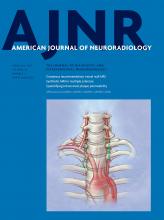We thank Morelli et al for their comments regarding our article “CT Perfusion in Acute Lacunar Stroke: Detection Capabilities Based on Infarct Location.” We acknowledge the important points our colleagues raised concerning lacunar infarcts and have responded to those comments below.
To begin, we agree that the size of lacunae should be defined as <15–20 mm. Although both 15 and 20 mm have been suggested as the uppermost diameter limit for lacunar infarcts, we chose to use 20 mm to be consistent with other recent publications on the topic.1
However, we disagree with our colleagues' conclusion that the definition of lacunae should only be used for infarcts within the deep perforator territory. Such restrictive use of the term “lacunae” ignores the variability in vascular supply throughout the brain. For example, supply to the caudate head from the artery of Heubner may arise either as a medial lenticulostriatal perforator or as a direct artery. Thus, the necessity that lacunar infarcts be located in the “deep” perforator territory prevents the inclusion of subcortical infarcts, which were shown in a study of 3660 participants to represent 11.9% of lacunae.2
Nevertheless, the distinction should be made between periventricular white matter (PVWM) contiguous with the ventricle, deep white matter (DWM), and subcortical white matter (SCWM) immediately subjacent to the cortex. According to this classification system used by Fazekas et al3 and Kim et al,4 the infarcts in Figs 2 and 3 of our article would be better classified as DWM, rather than SCWM as our colleagues stated, because they are located several millimeters deep to the unaffected overlying cortex.3,4 Even if our colleagues' presumption that only “deep” infarcts may be classified as lacunae is correct, it is speculative to conclude that these infarcts must be within the PVWM rather than the DWM.
Next, we agree with our colleagues that the contrast-to-noise (CNR) ratio and 10-mm sections are limitations of CTP imaging; both the CNR and section thickness may lead to partial volume artifacts, affect the absolute infarct size on CBV, and cause smaller infarcts to be missed. However, one aim of our study was to assess whether an abnormal perfusion or delay (ie, CBF and MTT) is present in the setting of lacunar infarcts, which theoretically could affect a larger area than a lacune (an example of this is seen in Fig 2). Hence, the sensitivity of CTP may be higher than first suspected because it may be used to arouse suspicion of lacunar infarcts when a severely elevated MTT or TTP region is observed. This is an area that deserves further study.
Finally, it is important to address our colleagues' presumption that DWI is the criterion standard in the setting of lacunar infarcts. A recent study showed that up to 29% of patients with nondisabling ischemic stroke have negative findings on DWI, and the prognosis in patients with negative findings on DWI was no better than those with positive findings on DWI.5 Furthermore, DWI positive for lesions in the setting of acute stroke sometimes demonstrates reversal of restricted diffusion.6 Our study compared CTP imaging with DWI—not with the clinical presence or absence of lacunar syndrome. The diagnostic capability of DWI would, therefore, naturally be superior to that of CTP because DWI was used as the criterion standard in our study. A direct comparison of both CTP and DWI with the presence or absence of clinically apparent lacunae would be needed to determine the relative sensitivity of both modalities, which was not performed in this study. This, too, is an area of potential future research.
References
- © 2017 by American Journal of Neuroradiology












